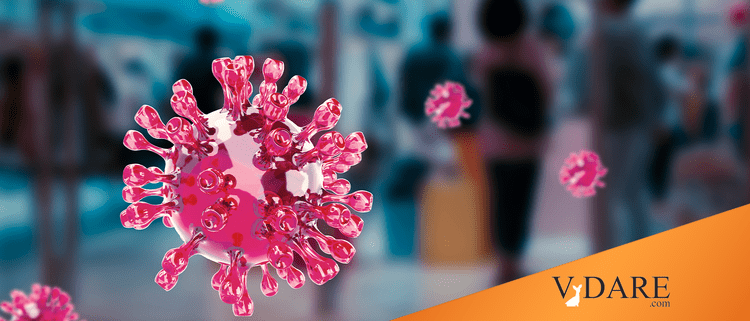


By Steve Sailer
01/15/2022
As in Johannesburg a few weeks ago, new cases of the Omicron Covid variant are now falling in New York City, with this Friday’s number of new cases a little under half of last Friday’s. Moreover, ICUs are not particularly packed, at least not yet: e.g., NYU’s medical center has 65 ICU beds empty.
The Omicron variant probably arrived in the U.S. at either New York’s JFK or Washington’s Dulles airport and then spread to other major air route big cities, and then from there into the hinterlands. So, other cities are behind NYC and D.C., but they are starting to look like they may be past their peaks too.
Chicago’s Cook County has seen a drop of approaching 50% in new cases since a week ago, and Los Angeles just had its first day in this wave with fewer cases than one week before.
In Los Angeles, for instance, about 0.4% of the population are registering newly positive each day in official tests shared with the public health authorities. If, say, for every person who gets an official positive test, there are four more who get infected without going into a database, I’m guessing that Omicron might tend to peak out in a metropolis at around 2% of the local population getting infected per day. At that rate, after a while, there aren’t that many people left to infect.
There’s a new study from the big Kaiser Permanente HMO in Southern California of over 50,000 Covid cases in December. It found about three-fourths Omicron, one fourth Delta. But because Omicron didn’t sink in in L.A. until the last third of the month, patient-days after testing positive are roughly equally divided in the sample between the old Delta and the new Omicron strain (a few % more Omicron patient-days)
This study, like several others, shows the new version to be less severe. Hospital stays averaged a median of 4.9 days for Delta and 1.5 for Omicron. (They eliminated from the study people who came into the hospital for some other reason and then were incidentally found to have Covid as well.)
| Worst Events | Delta | Omicron |
| ICU | 23 |
7 |
| Ventilator | 11 |
0 |
| Death | 14 | 1 |
On the other hand, Omicron didn’t much get to SoCal until the second half of December, so these ratios could narrow with more time. On the other other hand, 84% of admitted Omicron patients had been discharged from the hospital by the end of the study on January 1st vs. 78% of Delta patients.
Also, a higher percentage of Omicron patients were age 20-39.
But, in general, the Omicron experience looks nasty but quick.
The mRNA vaccines were less efficacious at preventing a symptomatic hospital admission for the new Omicron strain than for the recent Delta strain. If I’m reading Table S3 correctly, among Kaiser clients who tested positive as outpatients for Covid in December, two doses of Pfizer or Moderna cut your chances of being admitted to the hospital for Delta by 85%. In contrast, two shots cut your chances of being admitted for Omicron by 64%.
Interestingly, booster shots didn’t seem to have a noticeable incremental effect. Presumably, though, people who got booster shots tended to be older (and thus more vulnerable to needing to go to the hospital) and/or to have gotten their first two shots earlier in 2021 than people who didn’t get a booster shot, so the third shot likely has a modest beneficial effect. Hopefully, the authors will release their crosstabs on vaccination status.
I don’t see any data in this study relevant to the question of whether the vaccines slow the spread of Omicron, but it seems likely they aren’t doing much. They do seem to still be reducing hospitalizations by almost 2/3rds, which is important but less than the 5/6ths seen with Delta.
What about the future? If there are fundamental structural reasons that there is a trade-off so that more infectiousness goes along with less lethality, then Omicron won’t be a fluke and future variants should tend to evolve to be even more spreadable and even milder. One theory is that Omicron is so infectious because it hangs around in your upper respiratory tract, from where it’s easily spread, rather than burrowing into your lungs like previous variants that did more harm.
On the other hand, if it’s just random luck that this more infectious variant happens to be less dangerous, then the future is unwritten.
Another question is how long natural immunity to Omicron lasts. Just as the vaccines have lower efficacy against this version of Covid, it could be that the natural immunity induced by Omicron is weaker and/or shorter in duration.
Hopefully, therapeutics like Pfizer’s new Paxlovid set of pills will prove safe and effective. At the moment, both Paxlovid and the one monoclonal antibody that works on Omicron, sotrovimab, are in very short supply. But it seems not unlikely that we will get a reprieve for awhile so that if — or perhaps when — the next damn thing comes along, we’ll by then have enough of these two medicines on hand.
I’m guessing the next few weeks will be a giant hassle with lots of people out of work. Try not to suffer an appendicitis right now.
But then things should get better…at least for a while, although who knows what will come along next.
It could be that January 2022 is the climax of the pandemic and it will fade away, like the 1918 Spanish Flu, which had its last wave in 1920.
Then again, we’ve been hopeful before.